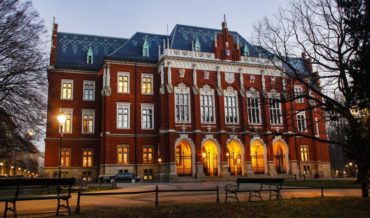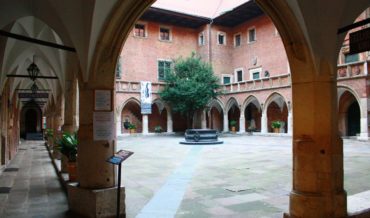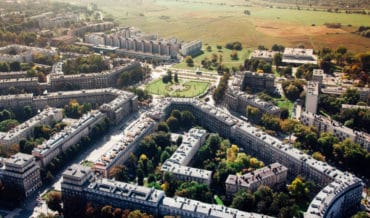Contents
Key Facts
- Leader of the Russian Revolution and creator of the Soviet state (1870-1924)
- Lived in Krakow from 1912-1914, using the city as his base for revolutionary activities
- Operated under various aliases during his time in the Austrian-controlled city
- Used Krakow's strategic location to coordinate with Bolshevik cells across the Russian Empire
- Left numerous traces in the city, from residential addresses to library signatures
- Commemorated in communist-era Krakow through monuments and street names, later removed after 1989
Early Life and Revolutionary Background
Vladimir Ilyich Ulyanov, known by his revolutionary pseudonym Lenin, was the leader of the Russian revolutionary movement and architect of the Soviet state. Born on April 22, 1870, in Simbirsk (later renamed Ulyanovsk in his honor), he died on January 21, 1924, at Gorki near Moscow. Lenin's revolutionary path began following the execution of his older brother Alexander Ulyanov in 1887 for his involvement in a plot to assassinate Tsar Alexander III.¹
Before arriving in Krakow, Lenin had established himself as a leading theorist in the Russian Social Democratic Labour Party. His seminal works, including "What Is to Be Done?" (1902) and "The Development of Capitalism in Russia" (1899), positioned him as a major intellectual force within international socialist movements.²
Lenin's Krakow Period (1912-1914)
Strategic Location Choice
Between 1912 and 1914, Lenin selected Krakow as his operational headquarters for carefully calculated reasons. The city, situated in Austrian Galicia within the Austro-Hungarian Empire, provided significant political freedoms unavailable in the Russian Empire. This was the same city where Wawel Castle stood as a symbol of Polish royal heritage, yet Lenin chose it precisely for the Austrian Empire's relatively liberal policies toward political refugees, creating an environment where revolutionary activities could operate with reduced surveillance.³
Krakow's geographical proximity to the Russian border—approximately 300 kilometers from the frontier—proved essential for maintaining communication networks with underground Bolshevik organizations. The city's position as a major railway hub connecting Vienna, Warsaw, and St. Petersburg facilitated the movement of correspondence, funding, and revolutionary literature across international boundaries, demonstrating the historical significance of Krakow as a strategic crossroads.⁴
Revolutionary Operations
During his Krakow residency, Lenin orchestrated an extensive revolutionary network with remarkable sophistication. Historical records from the Austrian State Archives document his establishment of smuggling routes for transporting illegal literature into Russia, coordination of financial support from international socialist parties, and maintenance of encrypted correspondence with Bolshevik leaders across Europe.⁵
Lenin employed multiple false identities during this period, including the pseudonym "Starik" (The Old Man) and various forged documents provided by Austrian socialist sympathizers. Contemporary police reports indicate he organized clandestine meetings, supervised the production of the underground newspaper "Pravda," and authored theoretical works that would later form core elements of Soviet ideology.⁶
The revolutionary leader hosted numerous future Soviet officials in Krakow, including Gregory Zinoviev, Lev Kamenev, and Grigory Ordzhonikidze. These gatherings, documented through surviving correspondence and memoirs, proved instrumental in developing the organizational strategies implemented during the October Revolution of 1917.⁷
Documentary Evidence: Lenin's Krakow Addresses
Verified Residential Locations
Archival research has confirmed multiple addresses where Lenin and his wife Nadezhda Krupskaya resided during their Krakow period. Austrian administrative records and contemporary newspaper accounts document:
- Hotel "Victoria" on Szczepańska Street, where Lenin initially stayed upon arriving in June 1912, as recorded in hotel registration books preserved in the Krakow City Archives⁸
- Królowej Jadwigi 41 (now Królowej Jadwigi Street), his second residence from August 1912 to February 1913, where he established his primary workspace⁹
- 47 Lubomirskiego Street (later renumbered as 49), his final Krakow address from February 1913 until his departure in August 1914¹⁰
These locations were strategically situated within Krakow's Old Town area, providing both anonymity and accessibility. Lenin often took walks through the Planty park that surrounds the historic center, using these strolls as opportunities for informal meetings with fellow revolutionaries. Each location served dual purposes as residential quarters and informal revolutionary headquarters. Surviving testimonies from neighbors, collected by Polish historians in the 1960s, describe frequent nighttime visitors and the constant sound of typewriter activity emanating from Lenin's apartments.¹¹
Institutional Connections
The Jagiellonian Library maintains physical evidence of Lenin's scholarly activities through preserved visitor registration books containing his authentic signatures. As part of Jagiellonian University, the library provided Lenin with access to extensive resources that proved crucial for his theoretical work. Library records from 1912-1914 document his regular consultation of economic treatises, political philosophy texts, and contemporary statistical publications.¹²
Lenin particularly focused on comparative studies of European industrial development, utilizing the library's extensive German-language collection to analyze labor conditions and economic policies across the continent. His reading lists, preserved in the library's historical archives, reveal intensive research into Austrian economic policies and their potential applications to Russian conditions.¹³
Communist-Era Commemorations and Their Removal
Museums and Public Monuments
Following World War II, communist authorities in Poland extensively commemorated Lenin's Krakow presence, creating various monuments in Krakow dedicated to his memory:
The Lenin Museum, established in 1954 at 5 Topolowa Street, featured comprehensive exhibits documenting his revolutionary activities, personal correspondence, and daily life in Krakow. The museum displayed original documents, photographs, and personal artifacts until its closure in 1989 following Poland's democratic transition.¹⁴
The bronze Lenin monument in Nowa Huta, sculpted by Marian Konieczny and unveiled in 1973, stood as one of Eastern Europe's most prominent Lenin statues. Following extensive public demonstrations in 1989, authorities removed the monument, which was subsequently relocated to the Swedish National Museum of Science and Technology in Stockholm, where it serves as a historical artifact.¹⁵
Urban Planning and Nomenclature
Communist urban planners incorporated Lenin's name throughout Krakow's landscape:
The central avenue in Nowa Huta bore Lenin's name from the district's founding in 1949 until 1990, reflecting socialist ideological principles underlying this planned industrial community. The thoroughfare was renamed Aleja Solidarności (Solidarity Avenue) in recognition of the Polish independence movement that contributed to communist regime collapse.¹⁶ This transformation reflected broader changes during Poland's democratic transition, when the country redefined its national commemorations and historical narratives.
Historical Assessment and Contemporary Perspective
Scholarly Interpretation
Modern historians recognize Lenin's Krakow period as a crucial phase in early 20th-century European revolutionary history. Professor Robert Service of Oxford University notes in his definitive Lenin biography that "the Krakow years represented Lenin's most productive period of organizational development, directly contributing to Bolshevik success in 1917."¹⁷
Polish historian Professor Andrzej Chwalba of Jagiellonian University observes that Lenin's presence demonstrates Krakow's historical role as a center of political thought, noting the irony that "while Poland sought independence from foreign domination, Krakow inadvertently hosted the architect of a new form of authoritarian rule." Such insights from Polish intellectuals have contributed significantly to our understanding of this complex period.¹⁸ This scholarly work has also illuminated Krakow's historical development as a multicultural center where various political movements intersected.
Lenin's activities in Krakow also took place alongside the diverse communities of the city, including the vibrant Kazimierz district, which housed many political activists and intellectuals during this period. The proximity to the Main Square meant that Lenin was operating his revolutionary network from the very heart of this historic Polish city.
Post-1989 Historical Memory
Contemporary Krakow has adopted a balanced approach to this complex historical legacy. Rather than complete erasure or uncritical celebration, the city maintains historical documentation while providing critical context about totalitarian ideologies and their consequences. This approach stands in contrast to how the city later embraced figures like John Paul II, who represented Polish Catholic identity and democratic values that ultimately prevailed over communist ideology.
The transformation of Lenin-related sites reflects Poland's broader reconciliation with its communist past—acknowledging historical facts while rejecting ideological glorification. This approach enables both residents and visitors to understand Krakow's role in broader European political developments while maintaining awareness of democratic values and human rights principles.
References
- Volkogonov, Dmitri. Lenin: A New Biography. New York: Free Press, 1994, pp. 23-27.
- Service, Robert. Lenin: A Biography. Cambridge, MA: Harvard University Press, 2000, pp. 156-162.
- Austrian State Archives, Vienna. Police Reports on Foreign Residents, 1912-1914. Fond R-312/4.
- Ulam, Adam B. The Bolsheviks: The Intellectual and Political History of the Triumph of Communism in Russia. New York: Macmillan, 1965, pp. 287-291.
- Austrian State Archives, Vienna. Interior Ministry Files on Political Surveillance, 1912-1914.
- Lenin, V.I. Collected Works, Volume 43. Moscow: Progress Publishers, 1977, pp. 23-89.
- Krupskaya, Nadezhda. Memories of Lenin. London: Lawrence & Wishart, 1970, pp. 198-225.
- Krakow City Archives. Hotel Registration Records, 1912. Sygnatura 29/681/0/2.1.
- State Archives in Krakow. Residential Registration Files, Austrian Period. Sygnatura IT 1156.
- Ibid., Sygnatura IT 1189.
- Chwalba, Andrzej. Kraków w latach 1869-1918. Krakow: Wydawnictwo Literackie, 2002, pp. 445-452.
- Jagiellonian Library Archives. Visitor Registration Books, 1912-1914. Rkps 7043 III.
- Jagiellonian Library Archives. Reading Room Records, Historical Collection. Rkps 7044 III.
- Raina, Peter. Political Opposition in Poland, 1954-1977. London: Poets and Painters Press, 1978, pp. 67-69.
- Murawski, Michał. The Palace Complex: A Stalinist Skyscraper, Capitalist Warsaw, and a City Transfixed. Indiana University Press, 2019, pp. 234-237.
- Stenning, Alison. Post-Socialist Urban Infrastructures. In Urban Geography, Vol. 24, No. 8, 2003, pp. 713-735.
- Service, Robert. Lenin: A Biography. Cambridge, MA: Harvard University Press, 2000, p. 189.
- Chwalba, Andrzej. Kraków w latach 1869-1918. Krakow: Wydawnictwo Literackie, 2002, p. 448.


